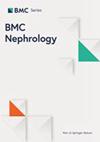中央透析输液系统对血液透析患者炎症指标的影响
IF 2.2
4区 医学
Q2 UROLOGY & NEPHROLOGY
引用次数: 0
摘要
事实证明,使用超纯透析液可以减少透析液污染,减轻炎症反应。中央透析液输送系统(CDDS)有可能达到与超纯透析液类似的纯度。然而,与单病种透析液输送系统(SPDDS)相比,有关 CDDS 对炎症影响的研究还很有限。本研究旨在探讨使用超纯透析液的 CDDS 对改善血液透析患者微炎症状态的影响。这项回顾性队列临床研究共招募了 125 名血液透析患者,其中 58 名患者来自 CDDS 单位,67 名患者来自 SPDDS 单位。对每位参与者进行了为期 6 个月的监测,并使用广义线性混合模型(GLMM)对重复测量数据进行了分析。研究队列的平均年龄为 56.22 ± 12.64 岁。GLMM 分析显示,在随访期间,时间*组对 hs-CRP 变化有显著的交互影响(β = -1.966, FTime* CDDS 组 = 13.389, P < 0.001)。随机斜率线性混合模型分析显示,CDDS组与SPDDS组的斜率不同(βCDDS=-0.793;βSPDDS=0.791),表明随访期间CDDS组的hs-CRP水平下降,而SPDDS组上升。然而,在随访期间,白蛋白和β2-微球蛋白水平没有观察到明显的时间*组交互效应(β2-微球蛋白:β = -0.658,FTime* CDDS 组 = 1.228,P = 0.269;白蛋白:β = 0.012,FTime* CDDS 组 = 1.429,P = 0.233)。与标准透析液相比,在 CDDS 中使用超纯透析液可改善 hs-CRP 水平,这可能会带来长期的临床优势。本文章由计算机程序翻译,如有差异,请以英文原文为准。
Effect of central dialysis fluid delivery system on markers of inflammation in hemodialysis patients
The utilization of ultrapure dialysate has been shown to decrease dialysate contamination and mitigate inflammatory responses. The central dialysate delivery system (CDDS) has the potential to attain a level of purity similar to ultrapure dialysate. Nevertheless, there is limited research examining the impact of CDDS on inflammation in comparison to single-patient dialysis fluid delivery system(SPDDS). This study aims to investigate the effects of CDDS utilizing ultrapure dialysate on ameliorating the microinflammatory state in hemodialysis patients. A retrospective cohort clinical study enrolled a total of 125 hemodialysis patients, with 58 patients from the CDDS unit and 67 patients from the SPDDS unit. Each participant was monitored for a period of 6 months, and the repeated measurement data was analyzed using a generalized linear mixed models (GLMM). The average age of the studty cohort was 56.22 ± 12.64 years. The GLMM analysis showed a significant time*group interaction effect on hs-CRP changes over the follow-up period (β = -1.966, FTime* CDDS group = 13.389, P < 0.001). A linear mixed model analysis with random slope showed that a different slope was observed between CDDS group and SPDDS group (βCDDS =—0.793; βSPDDS = 0.791), indicating a decreased hs-CRP levels in CDDS group, while increased in the SPDDS group over the follow-up period. However, no significant time*group interaction effect were observed on albumin and β2-microglobulin levels during follow-up period(β2-microglobulin: β = -0.658, FTime* CDDS group = 1.228, P = 0.269; albumin: β = 0.012, FTime* CDDS group = 1.429, P = 0.233). Using ultrapure dialysate in the CDDS is associated with an improvement in hs-CRP levels compared to standard dialysate, which might confer long-term clinical advantages.
求助全文
通过发布文献求助,成功后即可免费获取论文全文。
去求助
来源期刊

BMC Nephrology
UROLOGY & NEPHROLOGY-
CiteScore
4.30
自引率
0.00%
发文量
375
审稿时长
3-8 weeks
期刊介绍:
BMC Nephrology is an open access journal publishing original peer-reviewed research articles in all aspects of the prevention, diagnosis and management of kidney and associated disorders, as well as related molecular genetics, pathophysiology, and epidemiology.
 求助内容:
求助内容: 应助结果提醒方式:
应助结果提醒方式:


